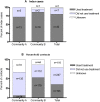Community management of endemic scabies in remote aboriginal communities of northern Australia: low treatment uptake and high ongoing acquisition
- PMID: 19478832
- PMCID: PMC2680947
- DOI: 10.1371/journal.pntd.0000444
Community management of endemic scabies in remote aboriginal communities of northern Australia: low treatment uptake and high ongoing acquisition
Abstract
Background: Scabies and skin infections are endemic in many Australian Aboriginal communities. There is limited evidence for effective models of scabies treatment in high prevalence settings. We aimed to assess the level of treatment uptake amongst clinically diagnosed scabies cases and amongst their household contacts. In addition, we aimed to determine the likelihood of scabies acquisition within these households over the 4 weeks following treatment provision.
Methods and findings: We conducted an observational study of households in two scabies-endemic Aboriginal communities in northern Australia in which a community-based skin health program was operating. Permethrin treatment was provided for all householders upon identification of scabies within a household during home visit. Households were visited the following day to assess treatment uptake and at 2 and 4 weeks to assess scabies acquisition among susceptible individuals. All 40 households in which a child with scabies was identified agreed to participate in the study. Very low levels of treatment uptake were reported among household contacts of these children (193/440, 44%). Household contacts who themselves had scabies were more likely to use the treatment than those contacts who did not have scabies (OR 2.4, 95%CI 1.1, 5.4), whilst males (OR 0.6, 95%CI 0.42, 0.95) and individuals from high-scabies-burden households (OR 0.2, 95%CI 0.08, 0.77) were less likely to use the treatment. Among 185 susceptible individuals, there were 17 confirmed or probable new diagnoses of scabies recorded in the subsequent 4 weeks (9.2%). The odds of remaining scabies-free was almost 6 times greater among individuals belonging to a household where all people reported treatment uptake (OR 5.9, 95%CI 1.3, 27.2, p = 0.02).
Conclusion: There is an urgent need for a more practical and feasible treatment for community management of endemic scabies. The effectiveness and sustainability of the current scabies program was compromised by poor treatment uptake by household contacts of infested children and high ongoing disease transmission.
Conflict of interest statement
The authors have declared that no competing interests exist.
Figures


References
-
- Hay R, Bendeck SE, Chen S, Estrada R, Haddix A, et al. Skin Diseases. In: Jamison DT, Breman JG, Measham AR, Alleyne G, Claeson M, et al., editors. Disease Control Priorities in Developing Countries, 2nd ed. Washington D.C.: IBRD/The World Bank & Oxford University Press; 2006. - PubMed
-
- Hengge UR, Currie BJ, Jager G, Lupi O, Schwartz RA. Scabies: a ubiquitous neglected skin disease. Lancet Infect Dis. 2006;6:769–779. - PubMed
-
- Martin JM, Green M. Group A streptococcus. Semin Pediatr Infect Dis. 2006;17:140–148. - PubMed
-
- McDonald M, Currie BJ, Carapetis JR. Acute rheumatic fever: a chink in the chain that links the heart to the throat? Lancet Infect Dis. 2004;4:240–245. - PubMed
Publication types
MeSH terms
LinkOut - more resources
Full Text Sources
Medical

